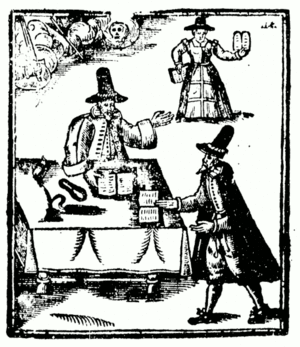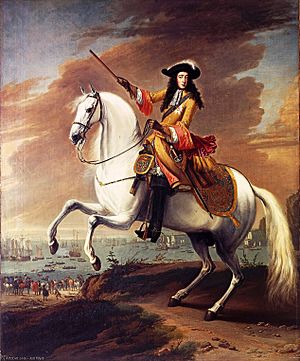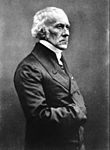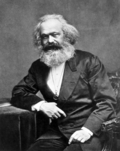English Revolution facts for kids
The English Revolution is a term used to describe two important times in English history. Before the 1900s, it usually referred to the Glorious Revolution of 1688. During this event, King James II was removed from power. A new system called a constitutional monarchy was set up with William III and Mary II as rulers.
However, some historians, especially those who follow Marxist ideas, started using the term for an earlier period. This period includes the Wars of the Three Kingdoms (1639-1651) and the time after King Charles I was executed in 1649. This time was called the Interregnum. It ended in 1660 when Charles II became king again in what was known as the Stuart Restoration. In 1892, Friedrich Engels called this earlier time "the Great Rebellion." He thought the Glorious Revolution of 1688 was "comparatively puny" (much smaller). But he believed both were part of the same big revolutionary movement.
Even though Charles II was later declared the rightful king since his father's death in 1649, some changes made during the Commonwealth period (when England was a republic) stayed in place.
Contents
The Glorious Revolution: A New Start
Problems with the English monarchy started long before the Glorious Revolution. In 1649, Charles I was executed by the English Parliament. After this, England became a republic, known as the Commonwealth. This lasted until Charles II became king again in 1660.
The civil wars that happened between 1649 and 1688 were about the country's rules and how much power the king had. These arguments were linked to changes that happened during the Reformation (a time of big religious change). People debated how much the government should be involved in church and state matters.
During the Glorious Revolution of 1688, King James II was replaced by William III and Mary II. This event created a constitutional monarchy. In this system, the king or queen shares power with Parliament and must follow the law. Historians who followed the Whig viewpoint called this the "English Revolution." They believed it was the final step in Parliament's long effort to create a balanced government in Britain, leading to more freedom.
Another View: The 'Great Rebellion'
The Marxist view of the English Revolution suggests that the events from 1640 to 1660 were a "bourgeois revolution." This means that the old system of feudalism (where land was owned by lords and worked by peasants) was replaced. A new class of people, the bourgeois (who were traders and business owners), gained power. They created a new society and government that supported capitalism (an economic system based on private ownership and profit).
This idea sees the English Revolution as a key moment in Britain's change from a feudal society to a capitalist one. It also marked a shift from a feudal state to a capitalist state.
Karl Marx first used the phrase "English Revolution" in a short text about the Glorious Revolution of 1688. Later, Friedrich Engels called the earlier conflict "The Great Rebellion." He still saw it as part of the same big revolutionary event. However, he thought the Glorious Revolution of 1688 was "comparatively puny" (much less important).
According to the Marxist historian Christopher Hill, the Civil War was a "class war." He believed King Charles I's rule was supported by old-fashioned forces like the Church and wealthy landowners. On the other side were the trading and industrial classes, along with farmers and ordinary people who understood what the fight was truly about.
Later Marxist ideas suggested that the English Revolution was a preview of the French Revolution and other revolutions. It showed how ordinary people could gain more power in government and the economy. For example, the guild democracy movement in London allowed transport workers, like the Thames Watermen, to make their companies more democratic in the 1640s. When the civil war started in 1642, rural communities began taking resources from royalist and church lands. Some communities even improved their land ownership rights.
After the main civil war ended in 1646, and especially after the monarchy returned in 1660, some of the old ways came back. However, some gains lasted a long time. For instance, the democratic changes made in the watermen's company in 1642 continued, with some ups and downs, until 1827.

The Marxist view also developed the idea of a "Revolution within the Revolution." Historians like Christopher Hill and Brian Manning focused on radical groups of the time. These included the Levellers (who wanted more equality), mutineers in the New Model Army (soldiers who rebelled), and the Diggers (who wanted communal land ownership). These groups tried to push for even bigger changes than Parliament after the Civil War.
Christopher Hill suggested there were "two revolutions" in England during the mid-1600s. One succeeded, establishing property rights and giving political power to property owners. This revolution removed old obstacles and helped the ideas of property owners to win. However, there was another revolution that almost happened. This one might have created shared property, a wider democracy, and a different kind of state church.
Brian Manning believed that the old ruling class came back with new ideas that helped economic growth. This eventually led to a fully capitalist economy. He thought things would have been very different if King Charles I had not been forced to call Parliament in 1640.
Why Some Disagree
While the Marxist idea is popular among some historians, many others disagree. Historians from more liberal or "revisionist" schools have criticized it.
For example, Austin Woolrych argued that the idea of the period being an "English Revolution" might be wrong. He pointed out that careful research showed that changes in land ownership and the ruling class were not as big as once thought. Woolrych believes that this idea ignores the lack of major social change during this time. It also ignores longer trends that happened before and after this specific period.
However, neither Karl Marx nor Friedrich Engels ever ignored how the capitalist state continued to develop, as seen in their writings about the Industrial Revolution.
Other Ways the Term Was Used
The term "English Revolution" was also used by non-Marxist writers in the Victorian period. For example, the critic Matthew Arnold used it in 1864 to refer to the events of 1642. He wrote, "This is what distinguishes it [the French Revolution] from the English Revolution of Charles the First's time."




